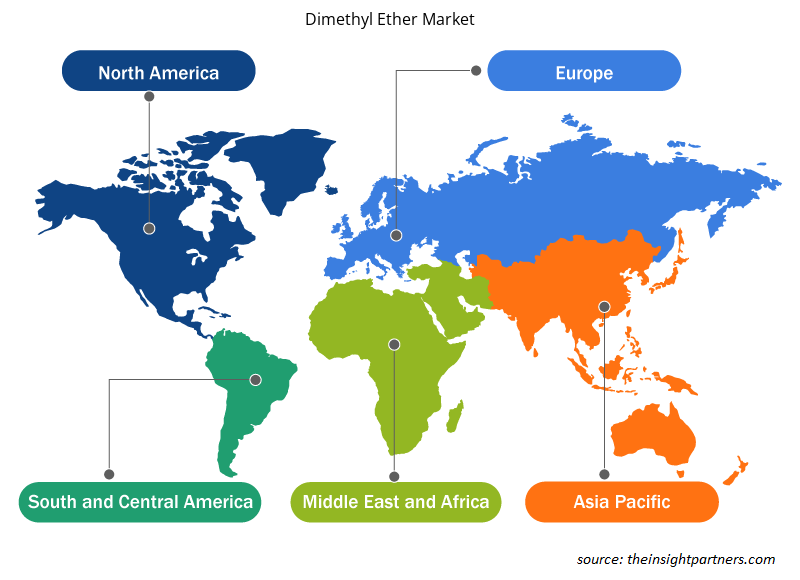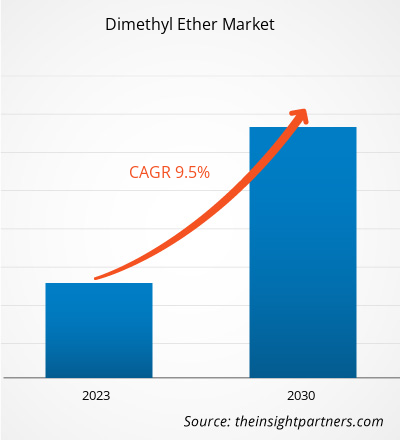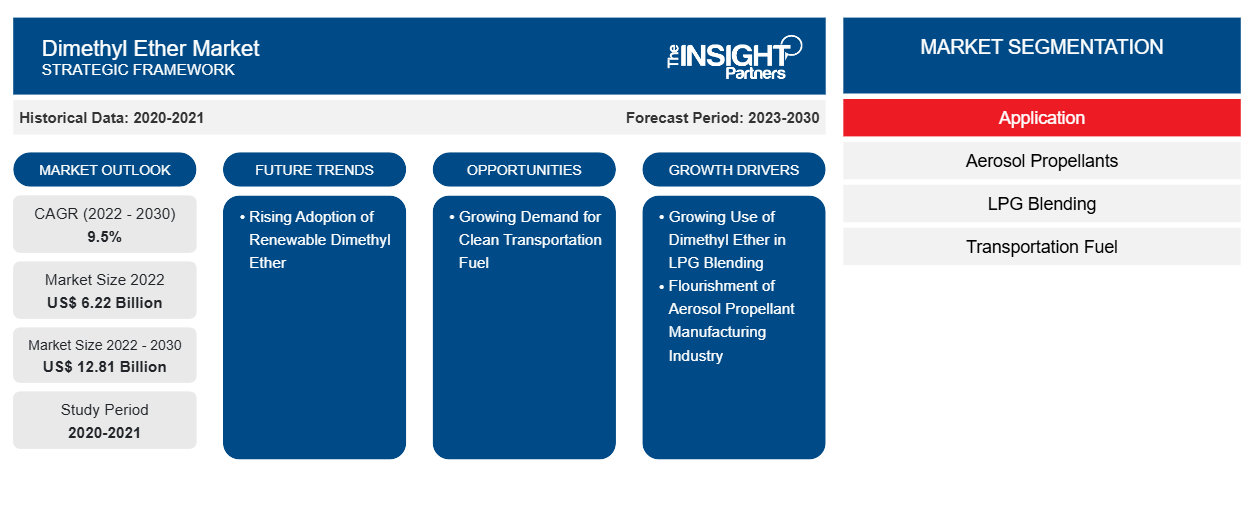[Informe de investigación] El tamaño del mercado de dimetiléter se valoró en US$ 6.216,45 millones en 2022 y se espera que alcance los US$ 12.808,32 millones para 2030; se estima que registrará una CAGR del 9,5% de 2022 a 2030.
Perspectivas del mercado y opinión de analistas:
El dimetiléter es un gas incoloro e inflamable a temperatura y presión ambiente. Se utiliza principalmente como propulsor en aerosoles y como componente de mezcla en GLP. El mercado del dimetiléter ha experimentado transformaciones significativas en los últimos años, impulsadas por sus aplicaciones versátiles y propiedades respetuosas con el medio ambiente. En respuesta a las preocupaciones mundiales sobre la calidad del aire y las emisiones de gases de efecto invernadero, el dimetiléter ha surgido como un candidato prometedor para reemplazar el combustible diésel tradicional. Este cambio se produce particularmente en regiones donde la reducción de las emisiones de los motores diésel es una prioridad máxima. Cuando se quema, el dimetiléter produce significativamente menos emisiones, particularmente en materia particulada, que los combustibles diésel convencionales. Como resultado, el dimetiléter ha ganado atención como una opción de combustible de combustión más limpia que se alinea con los objetivos de sostenibilidad y los requisitos regulatorios. Además, el dimetiléter se puede producir a partir de una variedad de materias primas, incluido el gas natural, el carbón y la biomasa. Esta adaptabilidad en las fuentes de materias primas mejora su atractivo como una solución energética renovable y sostenible y se espera que impulse el crecimiento del mercado del dimetiléter.
Factores impulsores del crecimiento y desafíos:
La compatibilidad de DME y GLP hace que la mezcla sea un proceso sin inconvenientes. El DME tiene propiedades físicas similares al GLP, como ser gaseoso a temperatura ambiente y licuarse fácilmente bajo presión moderada. Esta compatibilidad garantiza que las mezclas de DME y GLP se puedan almacenar, transportar y dispensar utilizando la infraestructura de GLP existente, como tanques de almacenamiento, redes de distribución y estaciones de servicio. Este aspecto reduce significativamente las barreras de entrada para la adopción de mezclas de DME y GLP y permite una integración más rápida en los sistemas de energía existentes. Las mezclas de DME y GLP ofrecen una solución de transición a medida que las industrias y los gobiernos buscan diversificar sus fuentes de energía y reducir la dependencia de los combustibles fósiles tradicionales. La creciente conciencia sobre las ventajas de las mezclas de DME y GLP promueve un panorama energético más sostenible y eficiente, impulsando así el crecimiento del mercado del éter dimetílico.
Sin embargo, la presencia de sustitutos potenciales como el gas natural comprimido (GNC) y el etanol podría limitar el crecimiento del mercado del éter dimetílico. Debido a su perfil de emisiones más bajo, el GNC se utiliza ampliamente como alternativa a la gasolina convencional y los combustibles diésel en el sector del transporte. Al igual que el DME, el GNC ofrece emisiones de gases de efecto invernadero y contaminantes del aire reducidas en comparación con los combustibles fósiles tradicionales. Esta superposición de beneficios podría conducir a la competencia entre el DME y el GNC, especialmente en regiones con una infraestructura de GNC bien desarrollada. Además, el etanol es otro sustituto que podría afectar al mercado del éter dimetílico, particularmente en términos de su uso como combustible alternativo y oxigenante en la gasolina. El etanol derivado de fuentes renovables, como la biomasa y las materias primas agrícolas, ha ganado atención como un combustible alternativo más limpio. Por lo tanto, la disponibilidad de productos sustitutos podría afectar negativamente al crecimiento del mercado del éter dimetílico.
Personalice este informe según sus necesidades
Obtendrá personalización en cualquier informe, sin cargo, incluidas partes de este informe o análisis a nivel de país, paquete de datos de Excel, así como también grandes ofertas y descuentos para empresas emergentes y universidades.
-
Obtenga las principales tendencias clave del mercado de este informe.Esta muestra GRATUITA incluirá análisis de datos, desde tendencias del mercado hasta estimaciones y pronósticos.
Segmentación y alcance del informe:
El mercado mundial de dimetiléter está segmentado en función de la aplicación y la geografía. Según la aplicación, el mercado de dimetiléter se segmenta en propelentes de aerosol, mezcla de GLP, combustible para transporte, combustible para generación de energía, materia prima química y otros. Por geografía, el mercado de dimetiléter está segmentado en América del Norte (EE. UU., Canadá y México), Europa (Alemania, Francia, Italia, Reino Unido, Rusia y el resto de Europa), Asia Pacífico (Australia, China, Japón, India, Corea del Sur y el resto de Asia Pacífico), Oriente Medio y África (Sudáfrica, Arabia Saudita, Emiratos Árabes Unidos y el resto de Oriente Medio y África) y América del Sur y Central (Brasil, Argentina y el resto de América del Sur y Central).
Análisis segmental:
Según la aplicación, el mercado del éter dimetílico se segmenta en propelentes de aerosol, mezcla de GLP, combustible para el transporte, combustible para la generación de energía, materia prima química y otros. Se espera que el segmento de combustible para el transporte registre un crecimiento significativo entre 2022 y 2030. A medida que los gobiernos, las industrias y los consumidores de todo el mundo priorizan cada vez más la sostenibilidad medioambiental y buscan alternativas a los combustibles fósiles convencionales, el DME surge como un candidato prometedor debido a sus propiedades únicas y su compatibilidad con las necesidades de transporte limpio. Uno de los principales impulsores de la demanda de combustibles limpios para el transporte es el requisito urgente de reducir las emisiones de gases de efecto invernadero y los contaminantes del aire. Los combustibles diésel convencionales contribuyen a la contaminación del aire y son una fuente considerable de emisiones de dióxido de carbono . El DME, por otro lado, ofrece varias ventajas medioambientales. Produce menores emisiones de partículas, dióxido de azufre y óxidos de nitrógeno que las fuentes tradicionales de emisiones de dióxido de carbono. El DME, por otro lado, ofrece varias ventajas medioambientales. Produce menores emisiones de partículas, dióxido de azufre y óxidos de nitrógeno que el diésel tradicional. Además, la combustión de DME genera menos gases de efecto invernadero, lo que contribuye a una calidad del aire más limpia y a un futuro más sostenible. Los combustibles limpios para el transporte, como el DME, se alinean bien con el esfuerzo mundial por cumplir con los objetivos de reducción de emisiones definidos en acuerdos internacionales como el Acuerdo de París. Los gobiernos están implementando regulaciones más estrictas para frenar las emisiones de los vehículos, lo que proporciona un entorno favorable para la adopción de combustibles más limpios. Como el DME se puede integrar fácilmente en los motores diésel existentes con modificaciones mínimas, proporciona una solución atractiva para las industrias que buscan una reducción inmediata de las emisiones con amplios cambios de infraestructura. Todos estos factores están impulsando el crecimiento del segmento de combustible para el transporte en el mercado del dimetiléter.dimethyl ether market is segmented into aerosol propellants, LPG blending, transportation fuel, power generation fuel, chemical feedstock, and others. The transportation fuel segment is expected to register significant growth from 2022 to 2030. As governments, industries, and consumers worldwide increasingly prioritize environmental sustainability and seek alternatives to conventional fossil fuels, DME emerges as a promising candidate due to its unique properties and compatibility with clean transportation needs. One of the key drivers behind the demand for clean transportation fuels is the urgent requirement to lessen greenhouse gas emissions and air pollutants. Conventional diesel fuels contribute to air pollution and are a considerable source of DME, on the other hand, offers several environmental advantages. It produces lower particulate matter emissions, DME, on the other hand, offers several environmental advantages. It produces lower particulate matter emissions, sulfur dioxide, and nitrogen oxides than traditional diesel. Moreover, DME combustion generates fewer greenhouse gases, contributing to cleaner air quality and a more sustainable future. Clean transportation fuels such as DME align well with the global push to meet emission reduction targets defined in international agreements such as the Paris Agreement. Governments are implementing stricter regulations to curb vehicle emissions, providing a favorable environment for the adoption of cleaner fuels. As DME can be easily integrated into existing diesel engines with minimal modifications, it provides an attractive solution for industries seeking immediate emissions reduction with extensive infrastructural changes. All these factors are driving the growth of the transportation fuel segment in the dimethyl ether market.
Análisis regional:
Según la geografía, el mercado del dimetiléter está segmentado en cinco regiones clave: América del Norte, Europa, Asia Pacífico, América del Sur y Central, y Oriente Medio y África. Se estimó que la región de Asia Pacífico rondaría los 1.000 millones de dólares en 2022. La región se ha convertido en un centro de fabricación global, con industrias que abarcan productos químicos, GLP, propulsores de aerosoles y producción de energía. El enfoque del gobierno en la sustitución de fuentes de combustible tradicionales por fuentes alternativas puede ofrecer oportunidades potenciales en el mercado del dimetiléter. Por tanto, a medida que la región progrese y se industrialice, se espera que la demanda de dimetiléter siga siendo fuerte, lo que se espera que impulse el crecimiento del mercado del dimetiléter en Asia Pacífico de 2022 a 2030. Se espera que Europa registre una CAGR de aproximadamente el 9% de 2022 a 2030. Los objetivos de sostenibilidad de Europa y la transición hacia fuentes de energía limpia han impulsado a los fabricantes a producir DME a partir de materias primas renovables. En 2021, SHV Energy y UGI International recibieron la aprobación de la Comisión Europea para formar una empresa conjunta para producir y utilizar dimetiléter renovable. Todos estos factores están impulsando el crecimiento del mercado del dimetiléter en Europa. Además, se prevé que América del Norte alcance un valor de unos 4.000 millones de dólares en 2030.
Desarrollos industriales y oportunidades futuras:
A continuación se enumeran varias iniciativas adoptadas por los actores clave que operan en el mercado del dimetiléter:
- En enero de 2021, Mitsubishi Corp inició las operaciones comerciales en su planta de metanol y dimetiléter (DME) en Trinidad y Tobago. La planta tiene una capacidad de producción anual de 1 millón de toneladas de metanol y 20.000 toneladas métricas de DME. La planta comenzó a operar comercialmente el 18 de diciembre de 2020. La planta está dirigida por Caribbean Gas Chemical Ltd (CGCL).
- En mayo de 2021, Oberon Fuels, productor de combustible de transporte de dimetiléter (DME) de combustión limpia, comenzó la producción de DME renovable (rDME) en EE. UU., y la única producción comercial actual.
Perspectivas regionales del mercado de éter dimetílico
Los analistas de Insight Partners explicaron en detalle las tendencias y los factores regionales que influyen en el mercado de dimetiléter durante el período de pronóstico. Esta sección también analiza los segmentos y la geografía del mercado de dimetiléter en América del Norte, Europa, Asia Pacífico, Oriente Medio y África, y América del Sur y Central.

- Obtenga datos regionales específicos para el mercado de dimetiléter
Alcance del informe de mercado de éter dimetílico
| Atributo del informe | Detalles |
|---|---|
| Tamaño del mercado en 2022 | US$ 6.22 mil millones |
| Tamaño del mercado en 2030 | US$ 12.81 mil millones |
| CAGR global (2022-2030) | 9,5% |
| Datos históricos | 2020-2021 |
| Período de pronóstico | 2023-2030 |
| Segmentos cubiertos |
Por aplicación
|
| Regiones y países cubiertos |
América del norte
|
| Líderes del mercado y perfiles de empresas clave |
|
Densidad de actores del mercado de éter dimetílico: comprensión de su impacto en la dinámica empresarial
El mercado del éter dimetílico está creciendo rápidamente, impulsado por la creciente demanda de los usuarios finales debido a factores como la evolución de las preferencias de los consumidores, los avances tecnológicos y una mayor conciencia de los beneficios del producto. A medida que aumenta la demanda, las empresas amplían sus ofertas, innovan para satisfacer las necesidades de los consumidores y aprovechan las tendencias emergentes, lo que impulsa aún más el crecimiento del mercado.
La densidad de actores del mercado se refiere a la distribución de las empresas o firmas que operan dentro de un mercado o industria en particular. Indica cuántos competidores (actores del mercado) están presentes en un espacio de mercado determinado en relación con su tamaño o valor total de mercado.
Las principales empresas que operan en el mercado del dimetiléter son:
- Nouryon Chemicals Holding BV
- Shell Sociedad Anónima
- Compañía química Mitsubishi Gas Inc.
- La compañía Chemours
- Aerosolex
Descargo de responsabilidad : Las empresas enumeradas anteriormente no están clasificadas en ningún orden particular.

- Obtenga una descripción general de los principales actores clave del mercado de dimetiléter
Impacto del COVID-19:
La pandemia de COVID-19 afectó negativamente a casi todas las industrias en varios países. Los confinamientos, las restricciones de viaje y los cierres de empresas en América del Norte, Europa, Asia Pacífico (APAC), América del Sur y Central, y Oriente Medio y África (MEA) obstaculizaron el crecimiento de varias industrias, incluida la industria química y de materiales. El cierre de las unidades de fabricación de las empresas de dimetiléter perturbó las cadenas de suministro globales, las actividades de fabricación y los cronogramas de entrega. Varias empresas informaron retrasos en las entregas de productos y una caída en las ventas de sus productos en 2020. La mayoría de las instalaciones de fabricación industrial cerraron durante la pandemia, lo que disminuyó el consumo de dimetiléter. Además, la pandemia de COVID-19 ha provocado fluctuaciones en los precios del dimetiléter. Sin embargo, varias industrias reanudaron sus operaciones después de que se resolvieron las limitaciones de suministro, lo que llevó a una reactivación del mercado del dimetiléter. Además, la creciente demanda de dimetiléter de los sectores de aplicaciones como la mezcla de GLP, los propulsores de aerosoles y los productos químicos está promoviendo sustancialmente el crecimiento del mercado del dimetiléter.
Panorama competitivo y empresas clave:
Entre los actores que operan en el mercado global de dimetiléter se encuentran Nouryon Chemicals Holding BV, Shell Plc, Mitsubishi Gas Chemical Co Inc, The Chemours Co, Aerosolex, Oberon Fuels Inc, Merck KGaA, Jiangsu July Chemical Co Ltd, Sichuan Lutianhua Co Ltd y Grillo-Werke AG. Los actores del mercado global de dimetiléter se centran en proporcionar productos de alta calidad para satisfacer la demanda de los clientes.
- Análisis histórico (2 años), año base, pronóstico (7 años) con CAGR
- Análisis PEST y FODA
- Tamaño del mercado, valor/volumen: global, regional y nacional
- Industria y panorama competitivo
- Conjunto de datos de Excel
Informes recientes
Testimonios
Razón para comprar
- Toma de decisiones informada
- Comprensión de la dinámica del mercado
- Análisis competitivo
- Información sobre clientes
- Pronósticos del mercado
- Mitigación de riesgos
- Planificación estratégica
- Justificación de la inversión
- Identificación de mercados emergentes
- Mejora de las estrategias de marketing
- Impulso de la eficiencia operativa
- Alineación con las tendencias regulatorias























 Obtenga una muestra gratuita para - Mercado de éter dimetílico
Obtenga una muestra gratuita para - Mercado de éter dimetílico